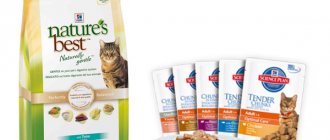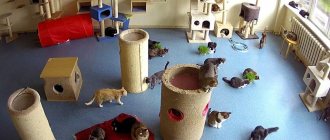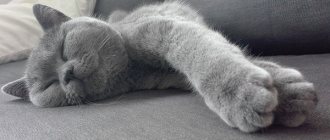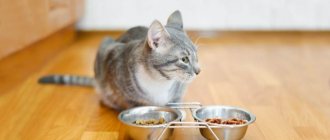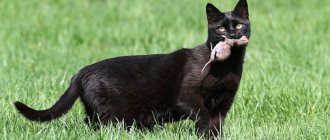Royal Canin is one of the most sought-after, recognizable and popular brands that specialize in the production of ready-made complete food for pets. Many owners of cats and dogs, planning to keep their pets on a ready-made diet, give preference to the products of the French company Royal Canin. The feed has a balanced composition, high quality, and a unique composition enriched with vitamins, minerals, and amino acids.
Given the truly large assortment, you can always choose a diet that fully corresponds to the individual, physiological, and breed characteristics of the body. The line includes food for various age groups and dog breeds. Specialized dietary and therapeutic food from Royal Canin deserves special attention. For example, products for animals with allergies, pets with a sensitive gastrointestinal tract, as well as for sterilized, neutered cats and dogs.
Features of nutrition of sterilized cats
Removal of the testes in males and the ovaries and uterus in females affects the functioning of the genitourinary system. Hormonal levels change, the need for energy decreases, and appetite increases.
Metabolism slows down. When choosing the type of power supply, this must be taken into account. Otherwise, illness may occur.
Spayed and neutered pets do not mark their territory, so their bladder is full before each trip to the toilet. They urinate only 1-3 times a day. This can cause sand, crystals and rocks to form. Nutrition should be aimed at diluting concentrated urine. This is exactly what special food for sterilized cats is designed for.
The production of sex hormones (estrogen in females and testosterone in males) stops. Animals become calm, aggression disappears. They do not need to regularly update their marks, look for a partner, or fight with rivals. Their activity decreases. This does not mean that spayed or neutered pets only eat and sleep. They can run and play, but they rarely do this. Therefore, the risk of obesity increases.
Testosterone is not only responsible for masculinity and sex drive, but also maintains optimal weight. Estrogen controls appetite. Stopping the production of these hormones leads to a slowdown in metabolism. Animals want to eat more often and more. This causes the deposition of subcutaneous fat.
The diet of sterilized domestic cats and neutered male cats should be aimed at maintaining a normal weight. Optimal body condition of an animal in itself is the prevention of diseases such as:
- diabetes;
- urolithiasis (UCD);
- fatty liver;
- arthrosis
Only a person can provide a cat with proper nutrition, health and care. It is important to follow the feeding schedule (2 or 3 times a day) and adhere to the daily intake, which is indicated by the manufacturer on the original packaging of the food. For this purpose, the pet must be weighed. It is recommended to feed the animal at the same time.
The diet must be balanced. Homemade food is not the best option for an obligate predator, especially a castrated or sterilized one. It is recommended to feed the animal either natural products (fresh meat and offal with the addition of a small amount of vegetables), or high-quality industrial food of at least premium class.
You cannot mix natural food and factory-made dry or wet rations. These are different types of food. The stomach and intestines get used to one type of food. If you constantly change the types of food, the animal may experience digestive problems.
Veterinarians recommend feeding spayed and neutered pets commercial food. Their formulation is developed taking into account the special needs of animals. Proteins, fats, carbohydrates, vitamins and minerals enter the body in the required quantities.
The diet of castrated and sterilized pets should include:
- 30-40% crude protein;
- 12-20% crude oils and fats;
- 30-45% carbohydrates;
- 5-7% fiber.
When feeding homemade food, it is difficult to achieve the above standards. In addition, it is important to properly balance the minerals: calcium, phosphorus and magnesium. Their excess or deficiency provokes ICD.
Sterilization and dietary requirements
Today this operation is very popular all over the world. According to statistics, about ¾ of the entire cat population is exposed to it. This reduces the number of unwanted pregnancies and abandoned kittens. However, it must be taken into account that the body also reacts to such intervention with hormonal disruptions, as well as significant metabolic changes. Typically, energy expenditure is reduced by about 30%, physical activity is reduced by half, and at the same time feed consumption, on the contrary, increases. This is because eliminating sex hormones directly affects the feeling of fullness. This is why it is extremely important to use special food for neutered cats. "Royal Canin" is an option that is not too expensive, but still has enough quality food for your pet.
Recommended daily feeding allowance
There are different types of Royal Canin dry and wet food for spayed and neutered pets. Depending on this, feeding rates may differ slightly from each other. The amount of food depends on the type of food chosen:
- dry food only;
- only canned food;
- combination of dry and wet food.
If dry Royal Canin Sterilized is the main component of the daily diet, the recommended feeding rates depend on the weight of the animal and are as follows:
- 3 kg - 47 g;
- 4 kg - 57g;
- 5 kg - 67 g;
- 6 kg - 76 g.
The above rates are daily allowances. They need to be distributed over 2-3 meals. If the pet is overweight, 10 g is subtracted from the daily dose. If the pet is underweight, the daily dose can be increased by 5-10 g.
When canned food is added to the diet, the amount of dry food is reduced by 15-20 g. If the diet includes 100% wet food for castrates, then the number of spiders (85 g each) depends on the weight of the animal:
- 3 kg - 2.5;
- 4 kg - 3;
- 5 kg - 3.5;
- 6 kg - 4.
When feeding dry food and/or canned food, your pet should always have access to clean water. Fluid intake is the best prevention of obesity and KSD. It is recommended to give filtered water to cats.
Food for overweight cats
If after surgery your pet begins to rapidly gain weight, then choose this food. It contains more plant ingredients: corn and wheat, and animal protein (poultry) is in third place in the composition. Additionally, the composition includes chicory extract and shellfish pulp flour, vegetable oils and extracts of medicinal herbs. First of all, a complex of antioxidants is important for an aging cat, which can, if not restore, then greatly prolong youth. Special additives ensure the health of the animal’s joints. The cost of packaging (6 kg) is 2890 rubles.
Description of the line
Royal Canin wet and dry food is produced in France, Poland and Russia. The line for sterilized cats includes the following diets:
- Kitten Sterilized. The food is suitable for neutered kittens from 6 to 12. To ensure growth and full development, it contains an increased amount of vitamins and minerals.
- Sterilized 37. The diet is intended for adult pets from 1 to 7 years.
- Sterilized 7+. This is a complete food for sterilized cats and cats over 7 years old. It is aimed at maintaining healthy bones, joints and preventing diseases of internal organs.
- Sterilized 12+. The food is enriched with antioxidants, suitable for neutered pets over 12 years of age.
If your animal is overweight or has an increased appetite, the following neutered foods are a good option:
- Sterilized Appetite Control. Thanks to the special type of fiber and low density of the kibble, cats are better satisfied and less likely to feel hungry. Suitable for pets from 1 to 7 years old.
- Sterilized Appetite Control 7+. The food is suitable for animals aged 7 years and older and contains antioxidants to maintain the youth of the body.
The line for sterilized cats also includes Royal Canin canned food:
- pieces in Sterilized sauce;
- pieces in jelly Sterilized;
- Sterilized pate;
- pieces in Kitten Sterilized sauce;
- pieces in Kitten Sterilized jelly.
Canned food is intended for sterilized pets over 1 year of age. Wet food labeled Kitten is given from 6 to 12 months.
Reviews from pet owners and veterinarians
What do experts say about Royal Canin for neutered cats? Reviews from veterinarians call it a relatively inexpensive food that can be used on an ongoing basis. Although doctors advise monitoring your pet, if he eats the food with pleasure, drinks and plays normally, and his fur is shiny, then the food is suitable for him. If you notice that the animal often sleeps, looks gloomy and unhealthy, then urgently change its diet. There are especially many positive reviews about the line of medicinal food from this manufacturer. The owners themselves often also note that the food is quite affordable and is very well accepted by their pets.
Contraindications for use
Royal Canin Sterilized cat food 37, 7+, 12+, as well as Appetite Control and Appetite Control 7+ should not be given to kittens. They contain insufficient amounts of vitamins and minerals for the full development of the animal up to 12 months.
The use of Royal Canin Kitten Sterilized food is contraindicated if the animal is 1 year of age or older. Elevated levels of vitamins and minerals can cause the development of KSD.
Advantages and disadvantages
- In the line of similar food, Royal Canin has a more than attractive price.
- The range of food is wide and there is even a division by breed (Maine Coons, Sphynxes, Siamese, British, Persian, Bengal cats).
- The food in this line can be combined with each other.
- They are sold in literally all pet stores, as well as in supermarkets with animal departments. It’s easy to order food online anywhere in the country.
- Manufacturers often organize promotions and sweepstakes among their customers, are active on social networks and notify about all the latest news in the field of production.
- According to independent studies of food samples, organoleptic indicators are normal. No infectious agents, salmonella, E. coli and mycotoxins were found, no traces of foreign impurities (metal shavings, sawdust, sticks), or traces of pests.
- Laboratory studies have shown the following: the proportion of fat does not correspond to that indicated on the label, but is underestimated. Moreover, it is significantly underestimated: by 28%. On the contrary, it contains too much fiber. The indicator of oxidative spoilage (peroxide value of fat) is higher than allowed for a product of this type, which means that by the end of the feed’s shelf life its taste characteristics will deteriorate (souring is also possible). In terms of the content of all amino acids, it contains incomplete (in terms of biological value) protein.
- Some samples contain wheat, corn and their derivatives, and soybeans. These products, which are useful to people, are of no benefit to carnivorous cats. They can cause allergic reactions (rashes, hair loss, dermatitis), promote rapid weight gain, diabetes, and problems with the digestive system.
- Plant protein is practically not digestible, causing bloating, increased gas formation, diarrhea or constipation.
- What kind of animal fat is used is not specified on the packaging. There is no detailed information on the official website either. Such mystery makes one doubt the quality. The same applies to yeast: brewer’s yeast is very useful for cats, but simply baker’s yeast, if it exists, is of no benefit.
Get acquainted with interesting cat breeds with the help of our encyclopedia: Napoleon, Neva Masquerade, Oriental.
Features of dry food
Dry food for castrates contains a reduced amount of raw oils and fats. This promotes weight control.
Thanks to the content of nutrients and their balance, the animal receives all the necessary vitamins, micro- and macroelements, and minerals. This has a positive effect on the condition of internal organs, skin health, the appearance of the coat, etc.
When using a dry commercial diet, it is important to ensure that cats consume 3 times more liquid than they eat food. Water helps flush sand and crystals out of the bladder. This is a good prevention of ICD.
Compound
- meat and meat by-products;
- vegetable by-products;
- vegetable protein isolate;
- dehydrated animal proteins;
- wheat, rice, corn and their derivatives;
- vegetable fats;
- vegetable fiber;
- hydrolyzed animal proteins;
- vitamins: A, D3, iron, iodine, copper, manganese, zinc, selenium, taurine, L-carnitine.
Other components:
- hydrolyzate from cartilage (source of chondroitin);
- Marigold erecta extract (source of lutein);
- borage oil (immune support);
- hydrolyzate from crustacean shells (source of glucosamine);
- LIP (specially selected proteins with a high degree of digestibility);
- yeast hydrolyzate (source of mannan oligosaccharides);
- tomatoes (source of lycopene);
- fructooligosaccharides;
- preservatives;
- antioxidants;
- clinoptilolite of sedimentary origin.
Feed ingredients
When choosing a product, the composition plays an important role. Food for sterilized pets contains the following components:
- dehydrated poultry protein;
- vegetable protein;
- wheat;
- cereal flour;
- fiber of plant origin;
- animal fats;
- hydrolyzed animal fats as a flavoring agent;
- rice;
- minerals;
- fish oil;
- yeast and their fermentation products;
- soybean oil;
- FOS;
- ammonium chloride
The downside is that the manufacturer does not indicate the percentage of components. In 1st place is poultry protein. We can come to the conclusion that this ingredient is the main one. This is a good indicator, since in economy-class feeds corn or wheat always ranks first.
Where is Royal Canin food made?
Most of the manufacturer's factories are located in France. One enterprise is located in Russia in the Moscow region. Animal owners note that, if possible, it is better to purchase French-made food. The recommendation is not without meaning: in Russia, the requirements for animal products are less stringent, so often the rations of the same manufacturer for foreign buyers are of higher quality. Additional factories are located in the USA, Brazil, Argentina, Great Britain, Canada and South Africa, but feed from there is not supplied to Russia.
The product logo is present on all food packaging
average cost
A 400 g package costs about 260 rubles. The average cost of 2 kg of feed is 1200 rubles. For a 4 kg package you will have to pay about 2200 rubles.
It is most profitable to take 10 kg cat food. The price of a bag varies between 5000-5200 rubles.
All information posted on the site is provided in accordance with the User Agreement and is not a direct instruction to action. We strongly recommend that before using any product, you must obtain a face-to-face consultation at an accredited veterinary clinic.



